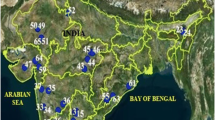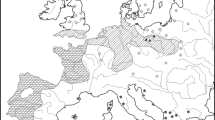Abstract
Key message
Species of Aesculus genus are divided into five main sections according to their susceptibility and resistance to horse chestnut leaf miner using molecular markers.
Abstract
Some species of the genus Aesculus are yearly severely infested by horse chestnut leaf miner (Cameraria ohridella). The larvae mine the leaves and under appropriate conditions can damage up to 100% of the leaf area. In this study, we assessed the genetic diversity of eight species of horse chestnut and their genotypes which have varying susceptibility to the leaf miner. Analysis of eight microsatellite loci showed high polymorphic information content 0.45–0.77 (0.60 in average) and high genetic diversity. For each locus, we found on average 5.50 alleles. During three vegetation periods, the leaf area damage of these genotypes was evaluated using the statistical software Assess 2.0. Different pressure of leaf miner and different development at each locality was recorded, and in some cases less damage was found, in one case the lesser damage was permanent. From the data, a pathological scale was established and a dendogram of similarity was created. Based on SSR analysis, four groups of Aesculus trees were distinguished according to their resistance or susceptibility and five main section+Hybrid were found. By cloning and analysing the inner transcribed spacers, the ITS1 and ITS2, inner and inter species variability was examined. For the sequence of hybrid species A. × carnea, no compliance was revealed in NBCI database. For this reason, the first sequence of this genotype was obtained.




Similar content being viewed by others
References
Aguilar FJ, Rosselló AJ, Feliner NG (1999) Nuclear ribosomal DNA (nrDNA) concerted evolution in natural and artificial hybrids of Armeraria (Plumbaginaceae). Mol Ecol 8(8):1341–1346
Blaalid R, Kumar S, Nilson HR, Abarenkov K, Kirks MP, Kauserud H (2013) ITS1 versus ITS2 as DNA metabarcodes for fungi. Mol Ecol Res 13(2):218–224
Blattner FR, Kadereit JW (1999) Morphological evolution and ecological diversification of the forest-dwelling poppies (Papaveraceae: Chelidonioideae) as deduced from a molecular phylogeny of the ITS region. Plant Syst Evol 219(3–4):181–197
Bruns E (2016) Fitness costs of plant disease resistance. eLS. Wiley, Chichester, pp 1–11
Buerki S, Lowry PP II, Alvarez N, Razafimandimbison GS, Küpfer P, Callmander WM (2010) Phylogeny and circumscription of Sapindaceae revisited: molecular sequence data, morphology and biogeography support recognition of a new family, Xanthoceraceae. Plant Ecol Evolut 143(2):148–159
Chanon MA (2005) Studies on the reproductive capacity of Aesculus parviflora and Aesculus pavia: oportunities for their improvement through interspecific hybridization. Dissertation, The Ohio State University
D´Costa EL (2014) Resistance and susceptibiliy to the invasive leaf miner Cameraria ohridella within the genus Aesculus. Dissertation, Royal Holloway, University of London
Doyle K, Corporation Promega (1996) Promega protocols and applications guide. Promega Corporation, USA
Ellis J, Dodds P, Pryor T (2000) Structure, function and evolution of plant disease resistance genes. Curr Opin Plant Biol 3(4):278–284
Forest F, Drouin NJ, Charest R, Brouillet L, Bruneau A (2001) A morphological phylogenetic analysis of Aesculus L. and Billia Peyr. (Sapindaceae). Can J Bot 79(2):154–169
Gálová Z, Vivodík M, Bálážová Ž, Hlozáková TM (2015) Identification and differentiation of Ricinus communis L. using SSR markers. Potravinárstvo 9(1):556–561
Gilbert M, Grégoire JC (2003) Visual, semi-quantitative assessments allow accurate estimates of leafminer population densities: an example comparing image processing and visual evaluation of damage by the horse chestnut leafminer Cameraria ohridella (Lep., Gracillariidae). J Appl Entomol 127(6):354–359
Hampl V, Pavlíček A, Flegr J (2001) Construction and bootstrap analysis of DNA fingerprinting-based phylogenetic trees with a freeware program FreeTree: application to Trichomonad parasites. Int J Syst Evol Microbiol 51(3):731–735
Hardin J (1957) A revision of the American Hippocastancea. Brittonia 9(3):145–171
Harris JA (2007) Molecular and morphological inference of the phylogeny, origin, and evolution of Aesculus L. (Sapindales). Dissertation, North Carolina State University
Harris JA, Xiang QY (2009) Estimating ancestral distributions of lineages with uncertain sister groups: a statistical approach to dispersal-vicariance analysis and a case using Aesculus L. (Sapindaceae) including fossils. J Syst Evolut 47(5):349–368
Harris AJ, Xiang QY, Thomas TD (2009) Phylogeny, origin, and biogeographic history of Aesculus L. (Sapindales)—an update from combined analysis of DNA sequences, morphology, and fossils. Taxon 58(1):1–19
Heinrich M, Pieroni A, Bremner P (2005) Plants as Medicines. In: Prance G, Nesbitt M (eds) The cultural history of plants. Routledge, New York, pp 205–238
Irzykowska L, Werner M, Bocianowski J, Karolewski Z, Frużyńska-Jóźwiak D (2013) Genetic variation of horse chestnut and red horse chestnut and trees susceptibility to Erysiphe flexuosa and Cameraria ohridella. Biologia 68(5):851–860
Isagi Y, Saito D, Kawaguchi H, Tateno R, Watanabe S (2007) Effective pollen dispersal is enhanced by the genetic structure of an Aesculus turbinata population. J Ecol 95(5):983–990
Kaneko Y, Takada T, Kawano S (1999) Population biology of Aesculus turbinata Blume: a demographic analysis using transition matrices on a natural population along a riparian environmental gradient. Plant Species Biol 14(1):47–68
Kenis M, Girardoz S, Avtzis N, Freise J, Heitland W, Grabenweger G, Lakatos F, Lopez-Vaamonde C, Svatos A, Tomov R (2003) Finding the area of origin of the horse-chestnut leaf miner: a Challenge. In: Proceedings: IUFRO Kanazawa 2003 “Forest Insect Population Dynamics and Host Influences”, pp 63–66
Lai Y, Fengzhu S (2003) The relationship between microsatellite slippage mutation rate and the number of repeat units. Mol Biol Evolut 20(12):2123–2131
LeRiche K, Eagle CHS, Crease J (2014) Copy number of the transposon, Pokey, in rDNA is positively correlated with rDNA copy number in Daphnia obtusa. PlosOne 9(12):21
Mertelík J, Kloudová K (2012) Evaluation of field resistance of the horse chestnut cultivar Mertelík to Cameraria ohridella. Acta Pruhoniciana 102:5–8
Mertelík J, Kloudová K, Vanc P (2004) Occurrence of Aesculus hippocastanum with high degree of resistance to Cameraria ohridella in the Czech republic. Acta Fytotechnica Et Zootechnica, Special Number, Proceedings of the XVI. Slovak an Czech Plant Protection Conference organised at Slovak Agricultural University in Nitra, Slovakia, Vol 7, 204
Mertelík J, Kloudová K, Stejskal J (2010) Utilization of horse chestnut clone M06 with resistant behaviour to horse chestnut leaf miner for seed production as a source of food in game preserves (in Czech). Acta Pruhoniciana 94(1):9–12
Minami E, Isagi Y, Kaneko Y, Kawaguchi H (1998) Polymorphic microsatellite markers in Japanese horse chestnut Aesculus turbinata Blume. Mol Ecol 7(11):1613–1621
Mishra KK, Fougat RS, Ballani A, Vinita T, Yachana Y, Madhumati B (2014) Potential and application of molecular markers techniques for plant genome analysis. Int J Pure Appl Biosci 2(1):169–188
Nejezchlebova M (2011) The study of the nature of resistance in the genus Aesculus to horse chestnut leafminer (Cameraria ohridella) (in Czech). Master Thesis, Mendel University in Brno, Lednice
Nováková P (2008) Bionomics of horse chestnut leaf miner (Cameraria ohridella) and their natural enemies from the order (Hymenoptera: Chalcidoidea); possibilities of defence (in Czech). Dissertation, Czech University of Life Sciences Prague
Page RDM (1996) TREEVIEW: an application to display phylogenetic trees on personal computers. Comput Appl Biosci 12(4):357–358
Promega (2010) pGEM®-T and pGEM®-T easy vector systems. Technical manual. http://www.promega.com/~/media/files/resources/protocols/technical%20manuals/0/pgem-t%20and%20pgem-t%20easy%20vector%20systems%20protocol.pdf. Accessed 23 Aug 2015
Provan J, Soranzo N, Wilson JN, Goldstein BD, Powell W (1999) A low mutation rate for chloroplast microsatellites. Genetics 153(2):943–947
Russel T (2005) Wood. In: Prance G, Nesbitt M (eds) The cultural history of plants. Routledge, New York, pp 315–333
Samek T (2003) Diapause of Cameraria ohridella Deschka et Dimic and its impact on the species population dynamics. Journal of Forest Science 49(6):252–258
Šefrová H (2007) New pests and changes of the insect species harmfulness in last decades. In: Bláha L (ed) Vliv abiotických a biotických stresorů na vlastnosti rostlin 2007 (in Czech). Conference proceedings from 21–22.3.2007. CULS Prague-Ruzyně, ČZU Prague, pp 31–37
Snieškienė V, Baležentienė L, Stankevičienė A (2011) State of horse-chestnut, Aesculus hippocastanum L., in Lithuania: diseases and pest damages. Ekologija 57(2):62–69
Steele H, Laue BE, MacAskill GA, Hendry SJ, Green S (2010) Analysis of the natural infection of European horse chestnut (Aesculus hippocastanum) by Pseudomonas syringae pv. aesculi. Plant Pathol 59(6):1005–1013
Straw NA, Tilbury C (2006) Host plants of the horse-chestnut leaf-miner (Cameraria ohridella), and the rapid spread of the moth in the UK 2002–2005. Arboric J 29:83–99
Thomas TD, Ahedor RA, Williams FCh, dePamphilis C, Crawford JD, Xiang QY (2008) Genetic analysis of a broad hybrid zone in Aesculus (Sapindaceae): is there evidence of long-distance pollen dispersal? Int J Plant Sci 169(5):647–657
Tozlu E, Demirci E (2010) First report of powdery mildew of Aesculus hippocastanum caused by Erysiphe flexuosa in Turkey. Australas Plant Dis Notes 5(1):61–62
Vejsadová H, Šedivá J, Vlašínová H, Havel L, Mertelík J, Kloudouvá K (2009) Organogenesis induction in horse chestnut (Aesculus hippocastanum L.) (in Czech). Zprávy lesnického výzkumu 54(4):286–292
Vyhnánek T, Nevrtalová E, Slezáková K (2009) Detection of the genetic variability of triticale using wheat and rye SSR markers. Cereal Res Commun 37(1):23–29
Vyhnánek T, Bačovský V, Vlašínová H, Havel L, Šedivá J, Mertelík J (2013) The study of genetic variability in the genus Aesculus L. by SSR markers (in Czech). Zprávy lesnického výzkumu 58(3):244–249
White TJ, Bruns T, Lee S, Taylor J (1990) Amplification and direct sequencing of fungal ribosomal RNA genes for phylogenetics. In: Innis MA, Gelfand DH, Sninsky JJ, White TJ (eds) PCR Protocols: a guide to methods and applications. Academic Press, New York, pp 315–322
Xiang QY, Crawford JD, Wolfe DA, Tang YCh, DePamphilis WC (1998) Origin and biogeography of Aesculus L. (Hippocastanaceae): a molecular phylogenetic perspective. Evolution 52(4):988–997
Zimmermannová-Pastirčáková K (2003) Occurrence of Horsechestnut leaf blotch and cultural characteristic of its causal agent-fungus Phyllosticta sphaeropsoidea, an anamorph of Guignardia aesculi. Folia Oecologica 30(2):245–250
Acknowledgements
The study was funded by institutional support (VUKOZ-IP-00027073). We greatly thank Dr. Alexander Oulton for revision of this paper.
Author information
Authors and Affiliations
Corresponding author
Ethics declarations
Conflict of interest
The authors declare that they have no conflict of interest.
Additional information
Communicated by W. Osswald.
Electronic supplementary material
Below is the link to the electronic supplementary material.
Rights and permissions
About this article
Cite this article
Bačovský, V., Vyhnánek, T., Hanáček, P. et al. Genetic diversity of chestnut tree in relation to susceptibility to leaf miner (Cameraria ohridella Deschka & Dimič). Trees 31, 753–763 (2017). https://doi.org/10.1007/s00468-016-1506-2
Received:
Accepted:
Published:
Issue Date:
DOI: https://doi.org/10.1007/s00468-016-1506-2




